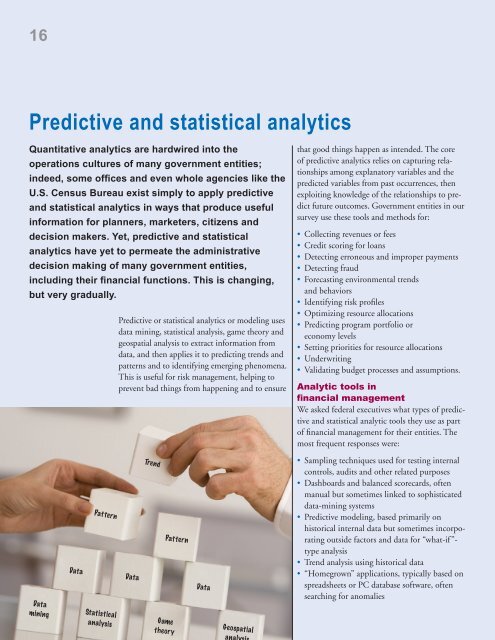CFOs: Surviving in a New Era - AGA
CFOs: Surviving in a New Era - AGA
CFOs: Surviving in a New Era - AGA
You also want an ePaper? Increase the reach of your titles
YUMPU automatically turns print PDFs into web optimized ePapers that Google loves.
16<br />
Predictive and statistical analytics<br />
Quantitative analytics are hardwired <strong>in</strong>to the<br />
operations cultures of many government entities;<br />
<strong>in</strong>deed, some offices and even whole agencies like the<br />
U.S. Census Bureau exist simply to apply predictive<br />
and statistical analytics <strong>in</strong> ways that produce useful<br />
<strong>in</strong>formation for planners, marketers, citizens and<br />
decision makers. Yet, predictive and statistical<br />
analytics have yet to permeate the adm<strong>in</strong>istrative<br />
decision mak<strong>in</strong>g of many government entities,<br />
<strong>in</strong>clud<strong>in</strong>g their f<strong>in</strong>ancial functions. This is chang<strong>in</strong>g,<br />
but very gradually.<br />
Predictive or statistical analytics or model<strong>in</strong>g uses<br />
data m<strong>in</strong><strong>in</strong>g, statistical analysis, game theory and<br />
geospatial analysis to extract <strong>in</strong>formation from<br />
data, and then applies it to predict<strong>in</strong>g trends and<br />
patterns and to identify<strong>in</strong>g emerg<strong>in</strong>g phenomena.<br />
This is useful for risk management, help<strong>in</strong>g to<br />
prevent bad th<strong>in</strong>gs from happen<strong>in</strong>g and to ensure<br />
that good th<strong>in</strong>gs happen as <strong>in</strong>tended. The core<br />
of predictive analytics relies on captur<strong>in</strong>g relationships<br />
among explanatory variables and the<br />
predicted variables from past occurrences, then<br />
exploit<strong>in</strong>g knowledge of the relationships to predict<br />
future outcomes. Government entities <strong>in</strong> our<br />
survey use these tools and methods for:<br />
• Collect<strong>in</strong>g revenues or fees<br />
• Credit scor<strong>in</strong>g for loans<br />
• Detect<strong>in</strong>g erroneous and improper payments<br />
• Detect<strong>in</strong>g fraud<br />
• Forecast<strong>in</strong>g environmental trends<br />
and behaviors<br />
• Identify<strong>in</strong>g risk profiles<br />
• Optimiz<strong>in</strong>g resource allocations<br />
• Predict<strong>in</strong>g program portfolio or<br />
economy levels<br />
• Sett<strong>in</strong>g priorities for resource allocations<br />
• Underwrit<strong>in</strong>g<br />
• Validat<strong>in</strong>g budget processes and assumptions.<br />
Analytic tools <strong>in</strong><br />
f<strong>in</strong>ancial management<br />
We asked federal executives what types of predictive<br />
and statistical analytic tools they use as part<br />
of f<strong>in</strong>ancial management for their entities. The<br />
most frequent responses were:<br />
Data<br />
m<strong>in</strong><strong>in</strong>g<br />
Pattern<br />
Trend<br />
Pattern<br />
Data Data Data<br />
Statistical<br />
analysis<br />
Game<br />
theory<br />
Geospatial<br />
an<br />
• Sampl<strong>in</strong>g techniques used for test<strong>in</strong>g <strong>in</strong>ternal<br />
controls, audits and other related purposes<br />
• Dashboards and balanced scorecards, often<br />
manual but sometimes l<strong>in</strong>ked to sophisticated<br />
data-m<strong>in</strong><strong>in</strong>g systems<br />
• Predictive model<strong>in</strong>g, based primarily on<br />
historical <strong>in</strong>ternal data but sometimes <strong>in</strong>corporat<strong>in</strong>g<br />
outside factors and data for “what-if”-<br />
type analysis<br />
• Trend analysis us<strong>in</strong>g historical data<br />
• “Homegrown” applications, typically based on<br />
spreadsheets or PC database software, often<br />
search<strong>in</strong>g for anomalies
















